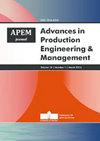逆向供应链过程中的高级风险评估:塞尔维亚共和国的案例研究
IF 2.8
3区 工程技术
Q2 ENGINEERING, MANUFACTURING
引用次数: 13
摘要
逆向供应链的管理往往发生在一个不确定的环境中,因此需要通过前瞻性的方法来分析,以避免/消除风险。基于评估的风险水平和潜在失效模式(PFM)优先级的管理举措应该会提高业务效率、竞争优势和RSC的可持续性。因此,本研究的重点是提出一种可靠的、用户友好的、适合于确定RSC中pfm风险水平和优先级的方法。与潜在失效效应(PEF)的严重程度及其频率相关的不确定性,以及pfm的检测,由预定义的语言表达式描述,并由区间型- 2梯形模糊数(IT2TrFNs)建模。将风险因素的相对重要性评价设置为模糊群决策。基于模糊数比较的方法计算权重向量。通过IT2TrFNs建模的预定义语言表达式来评估每个PFM水平上每个风险因素的值。采用改进的TOPSIS (technical of preference Order of Order by Similarity to Ideal Solution)方法获得排序。所提出的模型在塞尔维亚运营的RSC的真实数据上进行了测试。在实际影响方面,可能会注意到,应用所提出的模型可以减少潜在失败原因模式对整个供应链管理公司业务活动的影响,特别是在战略管理和人力资源实践方面。可以强调的是,所提出的模型的新颖性,因为它用于分析不同的RSC活动,并且经过分析后,所提出的管理措施可以解决许多相互关联的问题。©2019马里博尔大学CPE。版权所有。本文章由计算机程序翻译,如有差异,请以英文原文为准。
Advanced risk assessment in reverse supply chain processes: A case study in Republic of Serbia
Management of a reverse supply chain (RSC) often takes place in an uncertain environment, so it is supposed to be analyzed through the proactive approach for avoidance/elimination of risks. Management initiatives based on the as‐ sessed risk level and priority of potential failure mode (PFM) should lead to the increase of business effectiveness, the competitive advantage and sustain‐ ability of the RSC. Therefore, the focus of this research is set to proposing the reliable method that would be user‐friendly and suitable for the determina‐ tion of risk level and priority of PFMs in RSC. Uncertainties related to the severities of Potential Effect(s) of Failure (PEF) and their frequencies’, as well as detection of PFMs are described by pre‐defined linguistic expressions and modelled by the interval type‐2 trapezoidal fuzzy numbers (IT2TrFNs). The assessment of the relative importance of risk factors is set as a fuzzy group decision‐making. The weights vector is calculated based on the procedure of fuzzy number comparison. The value of each risk factor at the level of each PFM is assessed through the predefined linguistic expressions modelled by IT2TrFNs. The rank is obtained by modified Technique for Order of Prefer‐ ence by Similarity to Ideal Solution (TOPSIS) method. The proposed model is tested on a real‐life data from RSC that operates in Serbia. In the domain of practical implications, it may be noticed that the application of the proposed model could decrease the influence of potential causes of failures modes on the overall RSC business activities especially in the terms of strategic man‐ agement and human resource practices. The novelty of the proposed model may be underlined as it is used for the analysis of different RSC activities and many interconnected issues may be solved by the proposed management measures after conducted analysis. © 2019 CPE, University of Maribor. All rights reserved.
求助全文
通过发布文献求助,成功后即可免费获取论文全文。
去求助
来源期刊

Advances in Production Engineering & Management
ENGINEERING, MANUFACTURINGMATERIALS SCIENC-MATERIALS SCIENCE, MULTIDISCIPLINARY
CiteScore
5.90
自引率
22.20%
发文量
19
期刊介绍:
Advances in Production Engineering & Management (APEM journal) is an interdisciplinary international academic journal published quarterly. The main goal of the APEM journal is to present original, high quality, theoretical and application-oriented research developments in all areas of production engineering and production management to a broad audience of academics and practitioners. In order to bridge the gap between theory and practice, applications based on advanced theory and case studies are particularly welcome. For theoretical papers, their originality and research contributions are the main factors in the evaluation process. General approaches, formalisms, algorithms or techniques should be illustrated with significant applications that demonstrate their applicability to real-world problems. Please note the APEM journal is not intended especially for studying problems in the finance, economics, business, and bank sectors even though the methodology in the paper is quality/project management oriented. Therefore, the papers should include a substantial level of engineering issues in the field of manufacturing engineering.
 求助内容:
求助内容: 应助结果提醒方式:
应助结果提醒方式:


